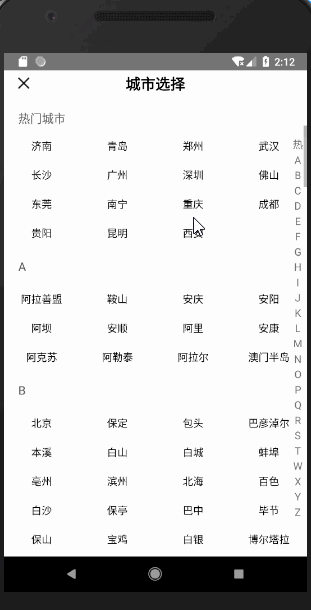引言
使用RN开发了一段时间,最近遇到了一个比较棘手的问题,就是用react写个城市选择列表,当然这个如果用Android原生来写,网上的例子数不胜数,随便就能找到,但是react却很少,也没有一个和我这个需求相匹配的,所以就只能自己动手撸一个出来咯.
效果
这个城市列表和其他的有点区别
1,有当前定位城市 2,有热门城市 3,每个子项是一个类似GridView的效果,而不是ListView 实现的效果图如下:

实现步骤
- 首先需要一个city.json的json文件 例:
{
"key": "A",
"data": [{
"citys": [
{
"city": "阿拉善盟",
"id": 152900
},
{
"city": "鞍山",
"id": 210300
},
{
"city": "安庆",
"id": 340800
},
{
"city": "安阳",
"id": 410500
},
.....]
}
- 整个列表采用sectionList
SectionList提供了粘性的header,设置为true即可
stickySectionHeadersEnabled=true,这样在滚动的时候就有实现了粘性效果;
代码如下:
<SectionList
ref="sectionList"
renderSectionHeader={this.renderSectionHeader}
renderItem={this.renderItem}
stickySectionHeadersEnabled={true}
showsHorizontalScrollIndicator={false}
sections={this.state.sections}
keyExtractor={this._extraUniqueKey}
/>
- 右边采用ScrollView来实现,最开始采用View,发现会有事件抢夺问题,具体的原因不祥,毕竟我对RN的事件传递也不是特别熟 代码如下:
/*右侧索引*/
sectionItemView() {
const sectionItem = this.state.sections.map((item, index) => {
if (index === 0) {
return null
}
return <Text key={index}
style={
[cityStyle.sectionItemStyle,
{backgroundColor: this.state.isTouchDown ? touchDownBGColor : touchUpBGColor}]
}>
{item.key}
</Text>
});
return (
<ScrollView style={cityStyle.sectionItemViewStyle}
ref="sectionItemView"
onStartShouldSetResponder={() => true}
onMoveShouldSetResponder={() => true}
onResponderTerminationRequest={() => true}
onResponderGrant={this.responderGrant}
onResponderMove={this.responderMove}
onResponderRelease={this.responderRelease}
>
{sectionItem}
</ScrollView>
);
}
这里的几个方法需要具体说明一下(React Native手势响应,就和android的onTouchEvent一个意思): 通过实施正确的处理方法,视图可以成为接触响应器。有两种方法来询问视图是否想成为响应器:
- View.props.onStartShouldSetResponder: (evt) => true,——这个视图是否在触摸开始时想成为响应器?
- View.props.onMoveShouldSetResponder: (evt) => true,——当视图不是响应器时,该指令被在视图上移动的触摸调用:这个视图想“声明”触摸响应吗? 如果视图返回 true 并且想成为响应器,那么下述的情况之一就会发生:
- View.props.onResponderGrant:(evt)= > { } ——视图现在正在响应触摸事件。这个时候要高亮标明并显示给用户正在发生的事情。
- View.props.onResponderReject:(evt)= > { }——当前有其他的东西成为响应器并且没有释放它。 如果视图正在响应,那么可以调用以下处理程序:
- View.props.onResponderMove:(evt)= > { }——用户正移动他们的手指
- View.props.onResponderRelease:(evt)= > { }——在触摸最后被引发,即“touchUp”
- View.props.onResponderTerminationRequest:(evt)= >true——其他的东西想成为响应器。这种视图应该释放应答吗?返回 true 就是允许释放
事件处理:
/*用户手指开始触摸*/
responderGrant(event) {
this.scrollSectionList(event);
this.setState({
isTouchDown: true,
})
}
/*用户手指在屏幕上移动手指,没有停下也没有离开*/
responderMove(event) {
console.log("responderMove")
this.scrollSectionList(event);
this.setState({
isTouchDown: true,
})
}
/*用户手指离开屏幕*/
responderRelease(event) {
console.log("onTouchUp")
this.setState({
isTouchDown: false,
})
}
/*手指滑动,触发事件*/
scrollSectionList(event) {
const touch = event.nativeEvent.touches[0];
// 手指滑动范围 从 A-Q 范围从50 到 50 + sectionItemHeight * cities.length
if (touch.pageY >= sectionTopBottomHeight+headerHeight+statusHeight
&& touch.pageY <= statusHeight +headerHeight+sectionTopBottomHeight + sectionItemHeight * 25
&& touch.pageX >= width - sectionWidth
&& touch.pageX <= width
) {
console.log("touchx" + touch.pageX + '.=======touchY' + touch.pageY)
const index = (touch.pageY - sectionTopBottomHeight - headerHeight) / sectionItemHeight;
console.log("index" + index);
if (Math.round(index)>=0&&Math.round(index)<=25){
this.setState({
selectText: this.state.sections[Math.round(index)].key
})
//默认跳转到 第 index 个section 的第 1 个 item
this.refs.sectionList.scrollToLocation({
animated: true,
sectionIndex: Math.round(index),
itemIndex: 0,
viewOffset: headerHeight
});
}
}
}
这里根据手指在右边索引栏的滑动事件,获取到当前的x轴和y轴的具体值,然后计算出具体的子项目的标题,让SectionList滚动到具体的index位置;
- 子项目列表采用FlatList实现GridView的效果
<FlatList
data={info.section.data[0].citys}
horizontal={false}
numColumns={4}
showsHorizontalScrollIndicator={false}
renderItem={({item}) => this._createItem(item)}
keyExtractor={this._extraUniqueKey2}
/>
这样基本大体的效果就实现了
最后
React native实现这个有个很坑爹的地方,就是渲染列表会花费很长的时间,Android是这样,ios没试过,所以如果没有渲染完就去滑动索引栏会报这个scrolltoindex-should-be-used-in-conjunction-with-getitemlayout-or-on异常,网上找了很多资料,说是SectionList没有渲染完就调用scrollToLocation,如果要在没有渲染完之前调用scrollToLocation需要配合getitemlayout使用,但是这个getitemlayout又需要传入具体item的高度,然而我的FlatList的高度是不确定的,所以就很坑爹了,找不到办法解决,只能延时加载右边索引栏;
代码如下:
componentDidMount() {
setTimeout(() => {
this.setState({
canTouch: true
})
}, 1600)
}
这样全部基本就完成了 项目地址: github.com/mouxuefei/R…